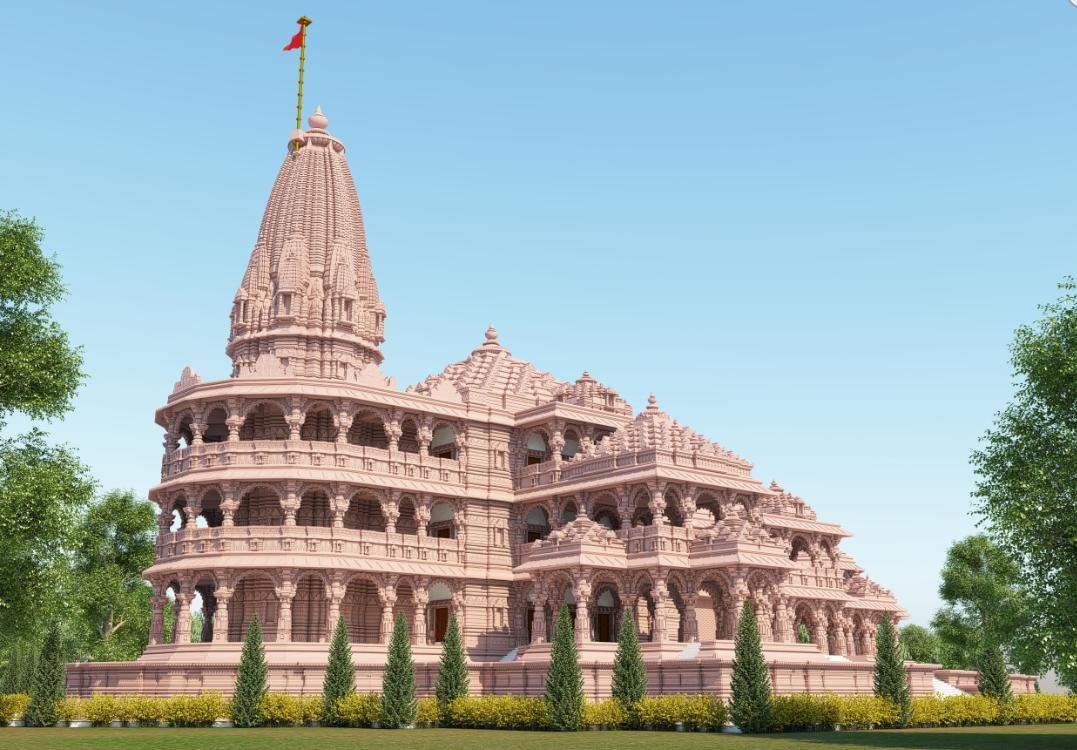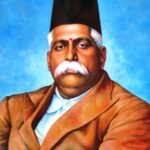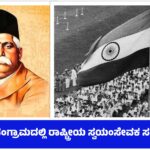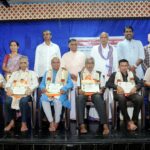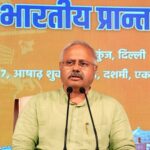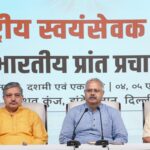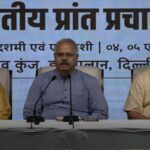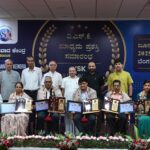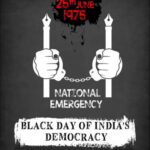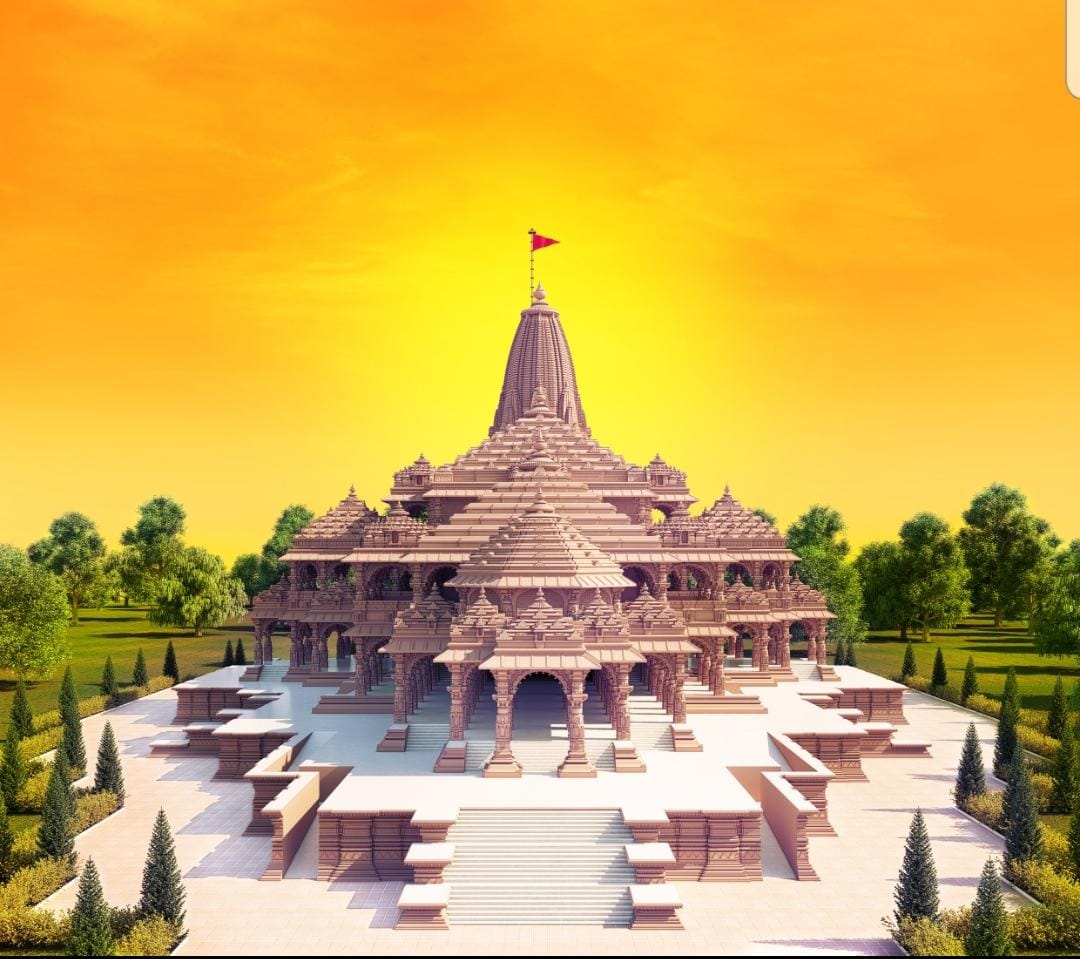
Ayodhya Ram Janmabhoomi Mandir : Symbol of Indian Ethos
Courtesy: Rashtrotthana Parishat
On August 5th, 2020 there is an inaugural function of commencement of rebuilding Shri Rama Temple, by conducting the Bhoomi Pooja. As a symbol of Social and National harmony and unity, the sacred soil samples from all the regions of India, water samples from all the rivers of India are being brought for worship and dedication. The auspicious moment awaited by the entire world over centuries, has arrived. On account of outbreak of Coronavirus in India, it is not being possible for Shri Rama devotees to come to Ayodhya to directly participate in this momentous celebration. However the holy worship is going to telecast live on Doordarshan from 10.30 am onwards for the benefit odf all the Indians. However to celebrate this national festive occasion in the family level, let us, all the worshippers of Srirama participate remotely from our respective houses by decorating our households with flowers and wreaths, lighting Lamps and incenses, making offerings, distribution of prasadam and observe meditations, chants, prayers and worship of Shri Rama and feel blessed.
Ayodhya was the capital of the Kosala Empire ruled by the world’s most brave kings. The kings of Ikshawaka clan, Surya or Raghu clan were very brave and philanthropists. This was the empire of the kings Sagara, Bhageeratha, Satya Harishchandra and king Dileep, who had occupied the thrones. The place of Ayodhya is identified and marked precisely right from the period prior to Shri Rama’s time to the present time. There are signs of the city having been reconstructed many a times. During the time of excavation, it was found that the buildings belonging to various periods having got buried in various layers one above the other.
The evidences collected in Ayodhya have reconfirmed the beliefs, the people are having on this sacred place. It also has been proved that Shri Rama was born at this sacred place. From the references in Ramayana about the time elements of nakshatras, planet positions at some important occasions, the experts have attempted to derive at the period of Shri Rama’s time. All these aspects declare the history of thousands of years apart from the available inscriptions and records. It is unique in the history of mankind in the records of existence being retained for such a long time.

In History
The five Theerthankaras (Gurus) of Jain religion were born here. The poet Kalidasa wrote his famous verse ‘Raghuvamsha’ at this place only. The place which is referred as ‘Saket’ in Budhdhist literature is the origin of referring Shri Rama as ‘Saket Rama’ in various devotional songs. On the inscription on the Ashoka pillar planted by King Ashoka in 249 BC, it has been stated that Shri Rama and Budhdha visited this place. This is the evidence for the history of Shri Rama. Maharana Pratap who fought against King Akbar, also belonged to the same Ikshwaku clan of Shri Rama. The founder of Sikh religion Guru Nanak had mentioned that he belonged to the Vedi clan of Shri Rama’s son Kusha and Guru Gobind Singh had claimed that he belonged to the Sodhi clan of Shri Rama’s son Lava. A temple for Shri Rama was built here from ancient times. According to the history, Shri Rama Temple built by king Kusha and was rejuvenated by King Vikramaditya.
These are just some examples. It has been recorded that the various kings of Shri Rama’s clan had ruled all the regions in India. This is enough proof of Shri Rama being a historic personality.
Babur’s Aggression
In the year 1527, when the king Rana Sangram Singh was defeated by Babur, no strong opponent to Babur remained in the northern India. Temples were destroyed, wealth was looted in plenty without any resistance. Babur’s commander Meer Baki invaded Ayodhya. Out of his fanaticism, he destroyed the temple at the birth place of Shri Rama and built a masjid above it, amidst a strong resistance by Hindus. It is said that he named the place as Babri Masjid. But till 1940 the place was called as Janmasthana Masjid. After that Ayodhya province was called an Awadh or Oudh. Administratively the place Ayodhya belonged to Faizabad district. And on the resolution of UP CM Shiri Yogi Adityanath, the entire district was re-named as Ayodhya District.
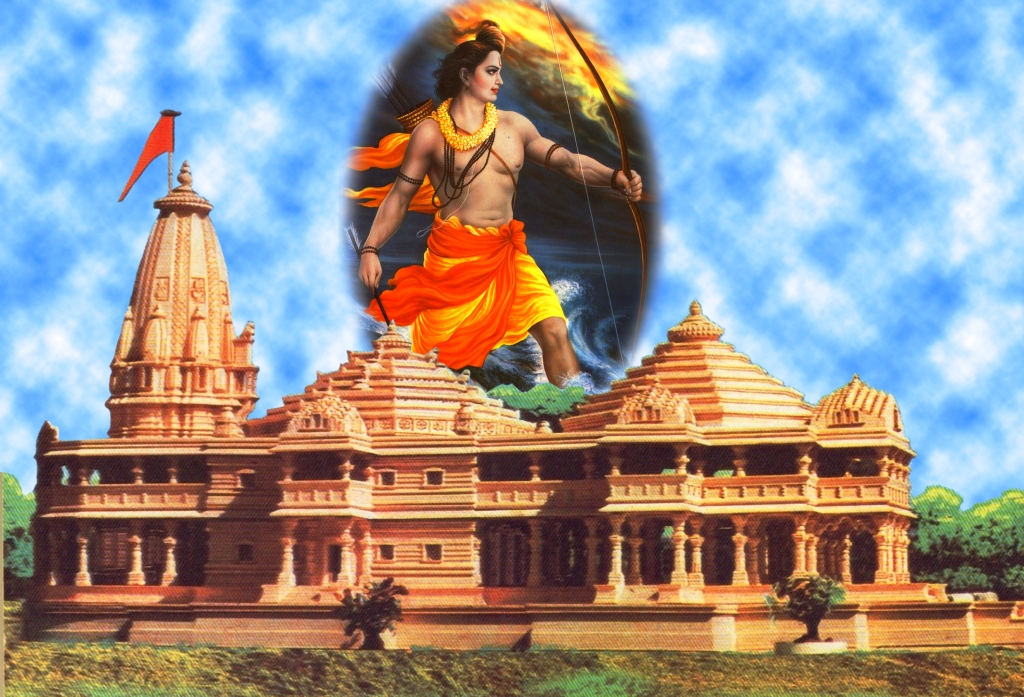
Unstoppable Conflict
During the regimes of various Muslim Kings, many temples in Ayodhya were destroyed. Some temples were forgotten by Hindus also. However the memory of Janmasthana temple remained intact in the memory of Hindus. Apart from that Hindus continued their unending struggle to reclaim the holy place.
According to the history, 80 wars have been fought to regain the Shri Rama janmasthana from the day the masjid was built over Shri Rama temple until this day. More than three lakhs of Hindus have lost their lives. Many a times this region came under the control of Hindus. There were attempts to offer an alternate land or money to the Nawab ruling that region, in order to reclaim the ownership of the place. In totality the memory of Shri Rama temple has never been out of the minds of Hindus.
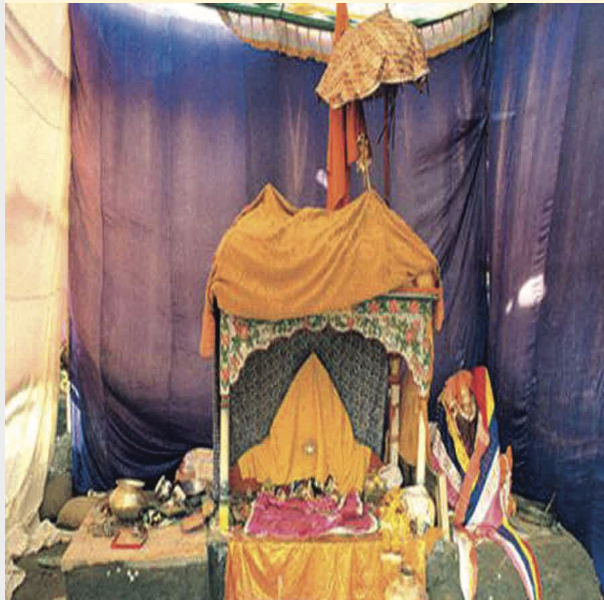
The wall built by the British
During the days of the first Independence war in 1857, the then Muslim Leader Aamir Ali had decided to hand over the entire temple complex to Hindus. But unfortunately the British won the war. The issue became much more complicated. As the British control on India grew up stronger, the British built a wall between the three domes and the Shri Rama Chabutara (the platform) adjacent to the premises of the disputed building, in order to control the daily fights between the two communities. Even during that juncture the daily worship of Shri Rama had continued without a stop.
Cow slaughter in Ayodhya
The fundamentalist Moulvis were successful in destroying the harmonious relationship developed between the two communities during the time of 1857 struggle for Independence. There was an involvement of the British also in this move of division among the two communities. As a result, conflicts, group clashes, small fights were taking place daily in Ayodhya. In 1934, cows were slaughtered in public places in Ayodhya by Muslims just to provoke Hindus. Hindu society got enraged by this incident. The killers of the cows were murdered. And the enraged Hindu youth stormed the disputed premises climbed up the three domes and caused serious damage. The British using heavy force vacated the place from Hindus. After that the Muslims never entered this place. In order to keep this conflict alive, the Collector of Faizabad, Nicholson collected heavy fines from Hindus in order to repair the tombs. Hence in a way this construction is rebuilt by the British. In spite of this, Hindus had continued visiting the place and the worship of the idols continued without stop on Chabutara (platform) outside the disputed building.
Inspiration from Somanath temple and the entry of Ram Lalla
As Sardar Patel announced that Somnath Temple will be rebuilt after Independence, there was a strong call for rebuilding a grand temple at Ayodhya. The long – time wishes of Hindu saints sprang up once again. In 1948, the Chief of Cow Protection Organisation Shri Vijaynath started correspondence on this subject with the Government.
There appeared an idol of Bala Rama (Young Shri Rama) in the disputed building with domes. This raised an excitement among Hindus. Shri Rama devotee Hindus from every corner of India rushed to have a holy darshan of Ram Lalla. The British felt insulted. The central government led by Mr Nehru got angry and brought pressure on the State Government to get the idol removed. But watching the power of enraged Hindu sentiments, the State Government did not dare to touch the idol. The worship of Ram Lalla continued from that time until today. And to prevent the entry of Hindu devotees into the disputed structure, Gates with grills were constructed to enable darshan only through the grill work.
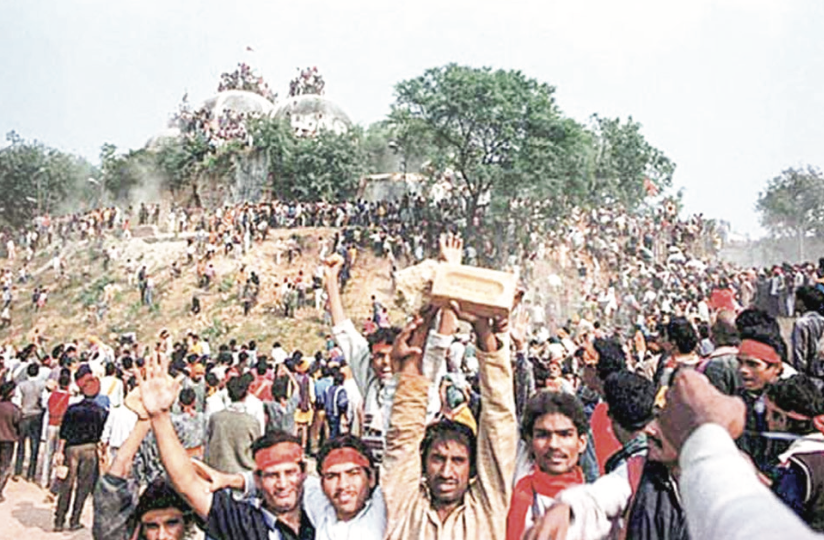
Construction of temporary structure for the Temple
In the 80’s the insistence to liberate Rama Janmabhoomi took a strong turn. Many meetings, confrences, conclaves and Ratha Yatras (Chariot Tour) were arranged under the leadership of Vishwa Hindu Parishat and other Hindu Organisations. Taala Kholo (Open the Lock) campaign enabled an opportunity to have darshan of Ramalulla on 1st February 1986. Unable to endure this, some Muslim leaders formed a Babri Masjid Action Committee and commenced a protest. The place was named as Babri Masjid from that moment. Insisting for the rejuvenation of Rama Janmabhoomi, Hindus took to Shri Ramajyoti procession ( procession with Lamps), Shilapoojana (idol worship) and erection of inscriptions on stones. In the year 1990 , lakhs of people from all over India started arriving at Ayodhya for Karseva . The then UP CM Shri Mulayam Singh Yadav got arrested the Karsevaks in order to suppress the movement. According to the Government records, around 1.8 Lakhs of Karsevaks were arrested.
In spite of that fresh Karsevaks arrived and Karseva continued unaffected. Enthusiastic karsevaks climbed on the domes and hoisted the Saffron Flag successfully. The then CM of UP Mr Kalyan Singh granted a land of 67 acres near the disputed land of 2.77 acres. The new land was to construct Rama Janmabhoomi Nyasa to conduct discourses of Rama Katha.
For the second round of Karseva in 1992 the devotees of Shri Rama in lakhs from all over India rushed towards Ayodhya, As a result of explosion of Hindu Kashatra Teja (Soldiers’ power), the structure which was like a blemish on Hindu dignity was razed to the ground. A temporarily constructed temple for Shri Rama was used to continue the worship.
The legal battle
In the decade of 1950 to 60, legal cases were lodged in courts
for occupation of disputed land by Shri Rama devotee Shri Gopal
Singh Visharad, Nirmohi Akhada and Sunni Wakf board. Since
that day till the final verdict in Supreme Court in 2019, trials and
hearings took place in various courts. For the resolution of the
dispute, various attempts were made both inside and outside the
courts. The Central Government in 1994 submitted an affidavit
to the court promising the handover of disputed land to Hindus,
if it is proved that a Hindu Temple existed in the place. On
the directions of the court, the Archaeological Survey of India
excavated in the place, found and reported the existence of a
Hindu Temple under the disputed structure along with evidences, which was upheld in the Allahabad High Court in 2010. In the same judgment, the land of 2.77 acres was divided in three equal parts and granted the three applicants.
This judgment was questioned in the Supreme Court. After many objections and prolonged hearings, the Supreme Court finally drew the curtain permanently on the dispute. Supreme Court directed the Central Government to form a necessary committee to build a grand Shri Rama Temple.
Temple, the symbol of National Identity
Hindu society waited over decades patiently and silently watching the court proceedings. Indians heard the strange interim judgements from time to time. Hindu Organisations did not refuse offers for out of the court settlements showing that harmonious co- existence is our priority but the same should not be on the burial of truth.
We are fortunate enough to become the witnesses of the auspicious occasion of singing the final anthem. The grand Shri Rama temple is not the sacred place only for Hindus. The temple is the National identity of India. Shri Rama is the ideal of India and is called as Maryada Purushottama. Shri Rama earned the friendship and help of the squirrel, Jatayu bird, divine monkeys like Anjaneya and Sugreeva and all the static and mobile forms of nature.
